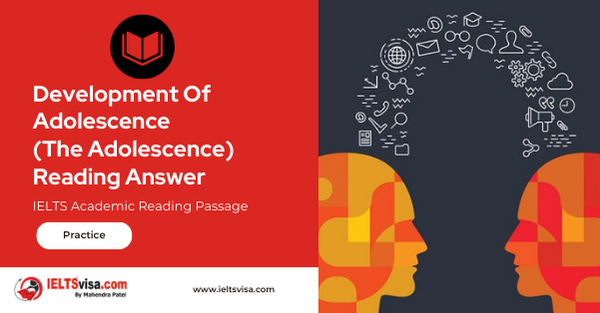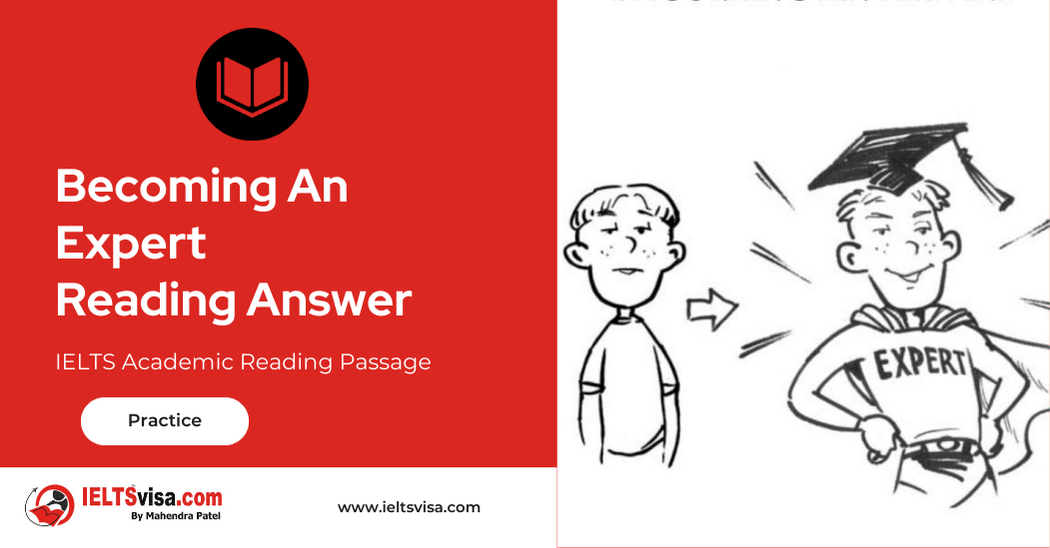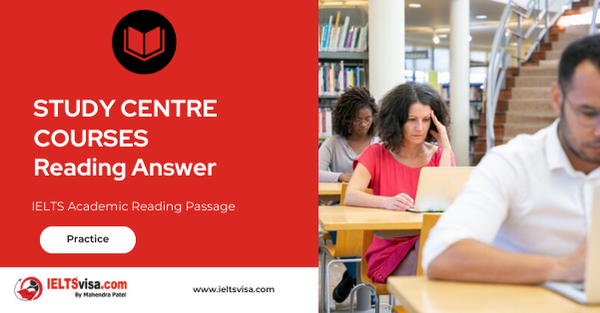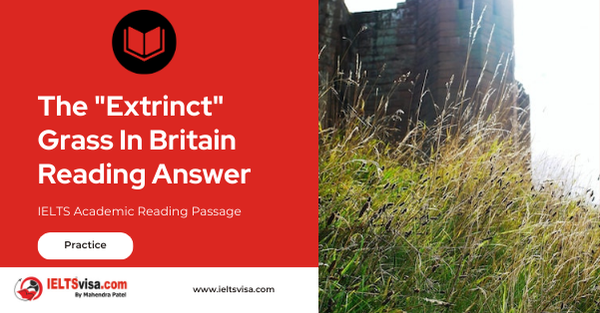Development Of Adolescence (The Adolescence) Reading Answer
IELTS Academic Reading Passage
A
The American Academy of Pediatrics recognizes three stages of adolescence. These are early, middle and late adolescence, and each has its own developmental tasks. Teenagers move through these tasks at their own speed depending on their physical development and hormone levels. Although these stages are common to all teenagers, each child will go through them in his or her own highly individual ways.
B
During the early years young people make the first attempts to leave the dependent, secure role of a child and to establish themselves as unique individuals, independent of their parents. Early adolescence is marked by rapid physical growth and maturation. The focus of adolescents’ self-concepts is thus often on their physical self and their evaluation of their physical acceptability. Early adolescence is also a period of intense conformity to peers. ‘Getting along,’ not being different, and being accepted seem somehow pressing to the early adolescent. The worst possibility, from the view of the early adolescent, is to be seen by peers as ‘different’.
C
Middle adolescence is marked by the emergence of new thinking skills. The intellectual world of the young person is suddenly greatly expanded. Their concerns about peers are more directed toward their opposite sexed peers. It is also during this period that the move to establish psychological independence from one’s parents accelerates. Delinquency behavior may emerge since parental views are no longer seen as absolutely correct by adolescents. Despite some delinquent behavior, middle adolescence is a period during which young people are oriented toward what is right and proper. They are developing a sense of behavioral maturity and learning to control their impulsiveness.
D
Late adolescence is marked by the final preparations for adult roles. The developmental demands of late adolescence often extend into the period that we think of as young adulthood. Late adolescents attempt to crystallize their vocational goals and to establish a sense of personal identity. Their needs for peer approval are diminished and they are largely psychologically independent from their parents. The shift to adulthood is nearly complete.
E
Some years ago, Professor Robert Havighurst of the University of Chicago proposed that stages in human development can best be thought of in terms of the developmental tasks that are part of the normal transition. He identified eleven developmental tasks associated with the adolescent transition. One developmental task an adolescent needs to achieve is to adjust to a new physical sense of self. At no other time since birth does an individual undergo such rapid and profound physical changes as during early adolescence. Puberty is marked by sudden rapid growth in height and weight. Also, the young person experiences the emergence and accentuation of those physical traits that make him or her a boy or girl. The effect of this rapid change is that young adolescent often becomes focused on his or her body.
F
Before adolescence, children’s thinking is dominated by a need to have a concrete example for any problem that they solve. Their thinking is constrained to what is real and physical. During adolescence, young people begin to recognize and understand abstractions. The adolescent must adjust to increased cognitive demands at school. Adults see high school in part as a place where adolescents prepare for adult roles and responsibilities and in part as preparatory for further education. School curricula are frequently dominated by the inclusion of more abstract, demanding material, regardless of whether the adolescents have achieved formal thought. Since not all adolescents make the intellectual transition at the same rate, demands for abstract thinking prior to achievement of that ability may be frustrating.
G
During adolescence, as teens develop increasingly complex knowledge systems and a sense of self, they also adopt an integrated set of values and morals. During the early stages of moral development, parents provide their child with a structured set of rules of what is right and wrong, what is acceptable and unacceptable. Eventually, the adolescent must assess the parents’ values as they come into conflict with values expressed by peers and other segments of society. To reconcile differences, the adolescent restructures those beliefs into a personal ideology.
H
The adolescent must develop expanded verbal skills. As adolescents mature intellectually, as they face increased school demands, and as they prepare for adult roles, they must develop new verbal skills to accommodate more complex concepts and tasks. Their limited language of childhood is no longer adequate. Adolescents may appear less competent because of their inability to express themselves meaningfully.
I
The adolescent must establish emotional and psychological independence from his or her parents. Childhood is marked by a strong dependence on one’s parents. Adolescents may yearn to keep that safe, secure, supportive, dependent relationship. Yet, to be an adult implies a sense of independence, of autonomy, of being one’s own person. Adolescents may vacillate between their desire for dependence and their need to be independent. In an attempt to assert their need for independence and individuality, adolescents may respond with what appears to be hostility and lack of cooperation.
J
Adolescents do not progress through these multiple developmental tasks separately. At any given time, adolescents may be dealing with several. Further, the centrality of specific developmental tasks varies with early, middle, and late periods of the transition.
Questions 1-6
Match the following characteristics with the correct stages of the adolescent.
Write the correct letter A, B or C, in boxes 1-6 on your answer sheet.
A early adolescence
B middle adolescence
C later adolescence
1. interested in the opposite sex
2. exposure to danger
3. the same as others
4. beginning to form individual thinking without family context
5. less need the approval of friends
6. intellectual booming
Questions 7-10
Complete each sentence with the correct ending, A-F, below.
Write the correct letters, A-F, in boxes 7-10 on your answer sheet.
7 ………………….. One of Havighurst’s research
8 …………………. High School Courses
9 …………………. Adolescence is a time when young people
10 ……………………. The developmental speed of thinking patterns
List of the statements
A. form personal identity with a set of morals and values
B. develops a table and productive peer relationships
C. are designed to be more challenging than some can accept
D. varies from people to people
E. focuses on creating a self-image
F. become an extension of their parents
Questions 11-13
Do the following statements agree with the information given in Reading Passage 1?
In boxes 11-13 on your answer sheet, write
TRUE if the statement is true
FALSE if the statement is false
NOT GIVEN if the information is not given in the passage
11. The adolescent lacks the ability to think abstractly.
12. Adolescents may have a deficit in their language ability.
13. The adolescent experiences a transition from reliance on his parents to independence.

Solution for: Development Of Adolescence (The Adolescence) Reading Answer
| 1. B | 8. C |
| 2. A | 9. A |
| 3. A | 10. D |
| 4. A | 11. FALSE |
| 5. C | 12. TRUE |
| 6. B | 13. TRUE |
| 7. E |
Review and Practice
- Regularly practice with IELTS reading samples and time yourself to get used to the pressure of the exam.
- Review your mistakes to understand where you went wrong and how to avoid similar errors in the future.
Our Books
Master IELTS Speaking Part 1
IELTS Writing Task 1 Book
IELTS Writing Task 2 Book
Development Of Adolescence (The Adolescence) Reading Answer Explanation
Comin Soon
Practice IELTS Other Modules
IELTS Listening
The IELTS Listening test assesses how well you can understand spoken English in various contexts. It lasts about 30 minutes and is divided into four sections with a total of 40 questions. The listening tasks become increasingly difficult as the test progresses.
IELTS Academic Reading
The IELTS Academic Reading section assesses your ability to understand and interpret a variety of texts in academic settings. It is designed to evaluate a range of reading skills, including skimming for gist, reading for main ideas, reading for detail, understanding inferences, and recognizing a writer's opinions and arguments.
IELTS Speaking
The IELTS Speaking test assesses your ability to communicate in English on everyday topics. It lasts 11-14 minutes and consists of three parts: introduction, cue card, and a discussion based on the cue card topic.
IELTS General Reading
IELTS General Reading tests your ability to understand and interpret various types of texts. Here are some key areas and types of content you can expect to encounter in the reading section, along with tips for effective preparation.
IELTS Academic Writing Task 1
In IELTS Academic Writing Task 1, you are presented with a visual representation of information, such as graphs, charts, tables, or diagrams, and you are required to summarize, compare, or explain the data in your own words.
IELTS General Writing Task 1
In IELTS General Writing Task 1, you are required to write a letter based on a given situation. The letter can be formal, semi-formal, or informal, depending on the prompt. Here’s a breakdown of the key components to include in your letter
IELTS Academic Writing Task 2
In IELTS Academic Writing Task 2, you are required to write an essay in response to a question or topic. Here’s a guide to help you understand the essential elements of this task
IELTS Exam Tips
To succeed in the IELTS exam, practice regularly, familiarize yourself with the test format, improve your vocabulary, develop time management skills, and take mock tests to build confidence.
Grammer for IELTS
Grammar is the foundation of effective communication in English. Understanding tense usage, subject-verb agreement, and sentence structure enhances clarity and coherence in writing and speaking.
Vocabulary for IELTS
Vocabulary plays a crucial role in the IELTS (International English Language Testing System) exam, especially in the Speaking and Writing sections. Here’s an overview of why vocabulary is important and how it impacts your performance
RECENT IELTS SAMPLES QUESTIONS AND ANSWERS
Becoming An Expert Reading Answer
A Expertise is commitment coupled with creativity. Specifically, it is the commitment of...
STUDY CENTRE COURSES Reading Answer
SELF-STUDY TIPS AHowever difficult you find it to arrange your time, it will pay off in the...
The Extrinct Grass In Britain Reading Answer
A The British grass interrupted brome was said to be extinct, just like the Dodo. Called...
Morse Code Reading Answer
A. A new satellite-based system is being implemented to replace Morse code for sending...
Magnetic Therapy Reading Answer
AMagnetic therapy, which is a $5-billion market worldwide, is a form of alternative medicine...
Lack Of Sleep Reading Answer
Section A It is estimated that the average man or woman needs between seven-and-a-half and...













